Belgian apples Black Prince
The Black Prince apples were bred at the end of the twentieth century on the basis of the popular American variety Jonagold. The clone quickly spread to Europe, the United States and Canada. He came to Russia in 1994, and was included in the official register only 20 years later. The second name of the clone is Red Jonaprince.
- Characteristics of the variety
- Advantages and disadvantages
- Description of the tree and fruit
- Taste
- Beneficial features
- Yield
- Winter hardiness
- Disease resistance
- Growing regions
- Harvest use
- Landing
- Landing dates
- Training
- Landing scheme
- Care
- Watering
- Top dressing
- Pruning
- Disease and pest control
- Preparing for winter
- Features of ripening and fruiting
- Harvesting and storage
- Gardeners reviews
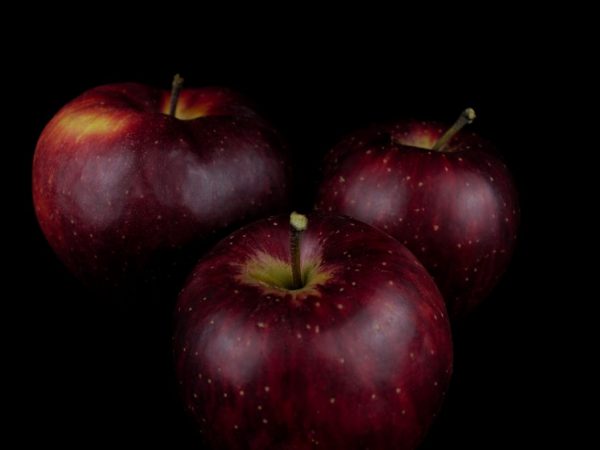
Belgian apples Black Prince
Characteristics of the variety
To choose the right apple tree for growing in your garden, you need to carefully read its characteristics. The varieties differ in height, growth rate, appearance and taste of the fruit. Each has its own characteristics of care and landing.
Advantages and disadvantages
Like other apple trees, the Black Prince variety has pros and cons.
The advantages include:
- early onset of fruiting
- stable yield
- excellent presentation of fruits and good taste
- keeping quality of apples
The disadvantages are:
- difficulties with pollination and pollinator selection
- low frost resistance
- fruits do not grow large with a lack of moisture
Description of the tree and fruit
The variety has a triploid set of chromosomes, like its parent. The tree is fast-growing, the height depends on the type of rootstock, the maximum is 5.5 m. The crown is dense, irregular in shape, which is why there is often an overload of fruits.
- The diameter of the apple is about 10 cm.
- Weight - within 200 g
- Color - dark red or red-black
- The peel is smooth, shiny, evenly covered with a waxy bloom
- The pulp is fine-grained, plump, of a yellowish-cream shade
Taste
According to the description, the Black Prince apple is juicy and crunchy, with a pronounced aroma. The pulp is sweet, with a pronounced sour aftertaste at the end.
The taste is spoiled if there are too many fruits on the tree. Then they become bland or too sour, with a weak aroma.
According to experts, the fruits earned 4.8 points out of five.
Beneficial features
Apples are recommended for people who want to lose weight.
Calorie content is low: only 42 kcal per 100 g.
They contain a lot of ascorbic acid, carotene (provitamin A), biotin, folic acid, vitamin PP, some vitamins from group B. These substances persist for a long time in the peel and pulp, and can replenish the supply of vitamins at the end of winter.

Fruits are rich in vitamins
Also, fruits contain minerals - magnesium, potassium, calcium, phosphorus. They strengthen the skeletal system, muscles, improve heart function. Fiber regulates the digestive tract, prevents constipation.
The variety is rich in antioxidants, prevents inflammation and cancer. Apples contain a lot of sugar, so they should be eaten with caution by patients with diabetes.
Yield
Apple trees bear fruit annually, in approximately the same quantity, they do not have breaks for "rest".Because of this stability, they are often grown commercially.
From dwarf and semi-dwarf rootstocks (they are used most often), you can get up to 70 kg.
If too many ovaries are formed, the size and taste of the fruit will deteriorate. Therefore, their number is advised to regulate.
Winter hardiness
The variety does not have high winter hardiness. The maximum temperatures that it can tolerate are 28⁰C, - 29⁰C. Therefore, it cannot be grown in all regions.
Before the onset of cold weather, the apple tree should be properly prepared for wintering.
Disease resistance
Most clones and hybrids are highly resistant to disease. But the Black Prince is sensitive to a variety of pathologies:
- powdery mildew
- scab
- bitter rot
- bitter pitting
Trees require preventive treatment for diseases. They need to be closely monitored so as not to miss the first signs and to take appropriate measures in time.
Growing regions
The Black Prince was hatched in the temperate zone.
Country of origin - Belgium: it has a maritime climate and rather mild, therefore, the variety has an average frost resistance.
Best suited for cultivation in the southern regions, central Russia. Apple trees are distributed almost throughout the territory of Ukraine, in Poland, the southern regions of Belarus.
The best producer of seedlings is Poland and Ukraine.
In the Moscow region and the Leningrad region, there is a risk that branches will freeze in winter. Therefore, the tree needs to be covered for the winter. It is better not to plant these apple trees beyond the Urals, in Siberia.
But in the Rostov region, in the Caucasus, the Kuban, in the Stavropol region, you can get bountiful harvests. It is recommended to grow the tree here on an industrial scale.
Harvest use
Under certain conditions, fruits can be stored for up to 9 months. Therefore, they are most often used for fresh consumption. In many supermarkets, dark red apples can be seen even in early summer.
If there is not enough storage space at home, the fruits are processed. Since the pulp is very juicy, it produces a lot of juice.
When canning, you do not need to add sugar: if sterilized correctly, the apples will not spoil and will have a natural sweetness. They also make jam, preserves, and jams from apples.
Landing
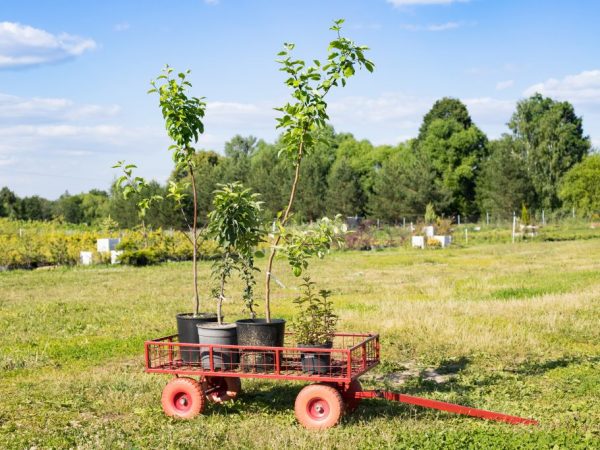
Choose your landing site carefully
The apple tree loves light loamy soils. It is undesirable to plant it in places where groundwater comes close to the surface.
6-7 months before planting, it is recommended to enrich the land with organic matter. To do this, 4 buckets of rotten manure or compost are applied to 1 m², then the site is deeply dug up.
Landing dates
Seedlings can be planted in the ground in spring or autumn.
- Spring planting is carried out when the soil warms up well (from about mid-April to mid-May).
- In autumn, trees are planted in mid or late October.
In the southern regions, the timing may shift 1-2 weeks back in the spring (until early April) or for the same time forward in the fall (until the first weeks of November).
If a tree is planted in autumn, it takes root well until spring, strengthens and begins to bear fruit faster. Disease resistance of such apple trees is higher. But with spring planting there is no risk of freezing, there is less chance that the seedlings will be damaged by hares and other rodents.
Training
Before planting, be sure to prepare a pit. If you plan to transfer seedlings to the ground in the fall, do it at the end of summer.
For spring planting, the pit is prepared at the end of October.
The bottom of the pit with clay soil is covered with drainage from expanded clay, pebbles or crushed brick. On sandy soil, you need to lay a layer of clay to retain moisture. Dimensions: 80 cm deep, 80-100 cm wide. The distance between the two pits is 4-4.5 m.
2-3 weeks before planting, a mixture is made of compost (manure) and fertile soil (1: 1), 0.5 liters of ash and 40-50 g of superphosphate. She is laid at the bottom of the pit.
Immediately before planting, the seedlings are carefully examined. The roots should be healthy, intact, without signs of rot.Any suspicious or broken roots are removed.
Inspect the vaccination site, it should not have cracks, softening, signs of fungal infection.
Landing scheme
- Clean soil is poured on top of the fertilizer layer.
- A peg, about 2 m high, is driven into the bottom.
- The root of the seedling is dipped into a mash made of clay with the addition of a growth stimulant.
- A mound is formed from the earth and the nutrient mixture.
- The seedling is placed above the top, and the roots are straightened around.
- Hold the apple tree vertically and gradually fill the hole so that the earth evenly fills the space between the roots.
- Make sure that the root collar remains free, 2-3 cm above the ground.
- Consolidates the soil at the trunk.
- An earthen rampart is built at a distance of 30-40 cm from the trunk.
- Pour the seedling with 2-3 buckets of spring or settled water.
At the end, a tree is tied to a peg. Then they inspect the crown again, remove the broken branches. If the apple tree was planted in the fall, the trunk is tied with cloth and film to protect it from rodents.
Care
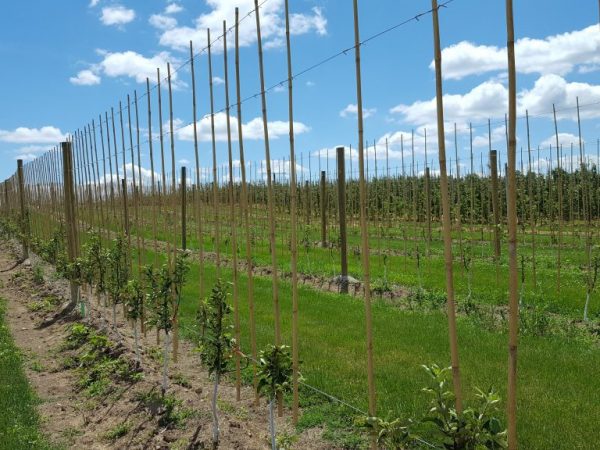
Plantings need good care
Proper care can increase the yield and longevity of the tree. It consists of:
- glaze
- feeding
- trimming
- prevention and control of pests and diseases
- preparation for wintering
Watering
The crop loves moderately moist soil and is sensitive to drought.
Young seedlings are advised to water 1-2 times a week, adults - once a month.
For 1 apple tree, you need to spend 1.5-2 buckets of water.
The best way is to spray with a watering can or a special hose. If this is not possible, a ditch or punctures are made in the ground at a distance of 60 cm from the trunk, 45-50 cm deep, and liquid is poured into it.
After watering, the soil around the trunk is loosened and covered with mulch with sawdust, peat, and chopped straw. This manipulation allows you to retain moisture longer.
Row spacings are advised to sow lawn grass so that water from the soil evaporates more slowly and lingers after rain.
Top dressing
Fertilizers are applied from the first year of the tree's life. At first, he will benefit from nitrogen, which stimulates growth. It is best to use urea or urea. Three tablespoons of this or that substance are diluted in 15 liters of water and poured over 1 tree with a solution.
When the leaves on the tree have bloomed, you can apply foliar dressing. For this, sodium humate is used, 20 g is diluted in 10 liters of water. One tree will need 2 liters of solution. It is poured into a spray bottle and sprayed on the branches. Processing is carried out 3-4 times per season.
In the 2nd year, nitrophoska is used for feeding (it is suitable for spring feeding). Take 4 tablespoons of the substance and dilute in 20 liters of water. This amount is enough for 2 apple trees.
Before the start of fruit ripening, you can apply phosphorus fertilizers without nitrogen, after harvesting - potash fertilizers.
Pruning
Already from the 2nd year after planting, they begin to form a crown. It is best to leave 2-3 tiers of branches on the tree, the distance between them should be approximately the same. In relation to the trunk, the shoots should grow at an angle greater than 45 ° C.
Branches that are too close to the trunk are cut off. For the rest, you can do stretch marks or insert a wedge at the base.
The tree is often overloaded with fruit, so pruning should be done twice a year. All shoots are cut off, contributing to the thickening of the crown. Also pay attention to weak, diseased and broken branches.
Spring pruning must be completed before the juices begin to circulate. Autumn is carried out after the foliage has fallen, 2-3 weeks before the first frost.
Disease and pest control
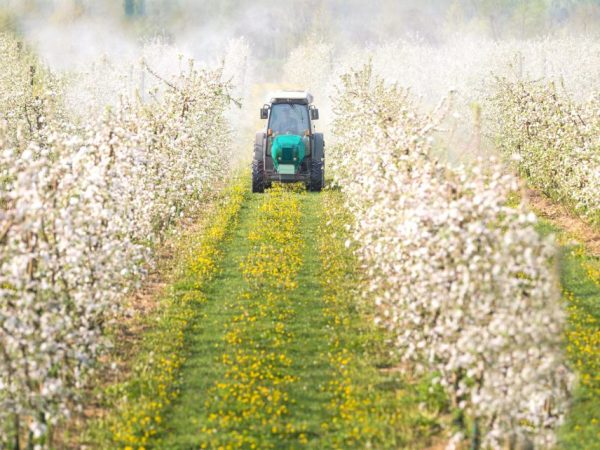
Processing will help maintain the health of apple trees
- Scab. Brown spots appear on leaves, fruits and shoots. Apples become smaller, their appearance worsens. Most often, the fungus infects the tree in hot and humid summers.
- Powdery mildew. The leaves are covered with a white or white-gray bloom, their ability to photosynthesize decreases. Plaque can also appear on fruits, yield and product quality decrease.In addition, the frost resistance of the apple tree decreases.
- Bitter rot. It is manifested by early decay of fruits, directly on the tree or during storage. The fruits start to taste bitter.
To combat fungi, fungicides, Bordeaux liquid are used. To prevent infestation, foliage must be carefully removed in the fall. With an early vein and during the formation of ovaries, it is necessary to carry out preventive treatment.
Bitter pitting is a disease associated with a lack of trace elements. First of all, these are potassium, calcium, magnesium and phosphorus. On apples, brown, depressed specks appear, 2-3 mm in diameter. They are more pronounced on the shaded side of the apple. The taste becomes bitter. To prevent the disease, you need to thin out the crown in time, carry out foliar dressing, and apply mineral fertilizers to the soil.
Among the pests, the most dangerous are apple moth, flower beetle, aphid, moth, spider mite. You can get rid of them with the help of insecticides:
- During the period of budding, a combination of Aktara and Horus drugs is used.
- When blooming buds - Rosebud with the addition of Tiovit Jet
- When the petals from the flowers begin to fall off, the Preparations of Aktar or Engio are combined with Match or Brand, Speed is added to the mixture.
- When the summer is especially rainy, use Aktara, Khors, Topaz
For prevention, they use folk remedies - infusion of tobacco, garlic, tansy.
Natural protection is well suited: for this, bird feeders are installed in the branches. They will fly in to feed, at the same time destroy the larvae of pests. In winter, they can even get them from under the bark.
Preparing for winter
The black prince does not tolerate frost well, so the apple tree needs to be properly prepared for winter.
- At the end of October, you need to water, 60-80 liters of water under one tree. This will compact the soil and prevent the roots from freezing.
- The trunk is wrapped with agrofilm, agrotextile or ordinary reeds to a height of up to 1.5 m. You can wrap the trunk and the base of the branches with a regular cloth, and then with two layers of paper and tie it with twine.
- Around the apple tree is lined with a layer of mulch (peat, sawdust) 20-25 cm thick
- To protect against hares, pine branches or barbed wire are placed on top of the mulch, the trunk is wrapped with a metal mesh or lapotnik
If a lot of snow falls in winter, you need to make a snowdrift around the tree, 40-50 cm high. This is good for protecting the roots from frost.
Features of ripening and fruiting
The Black Prince apple tree belongs to the winter varieties. It starts flowers a few days earlier than the parent variety. The flowers are large, pink.
Already in July, the apples turn red, but they are still immature. Fruit will reach full condition only at the end of September.
Fruiting begins early. On dwarf rootstocks, the first crop is harvested for 2-3 years, on semi-dwarf ones - for 4-5 years. Already at 6 years old, 50-60 kg can be harvested from one tree.
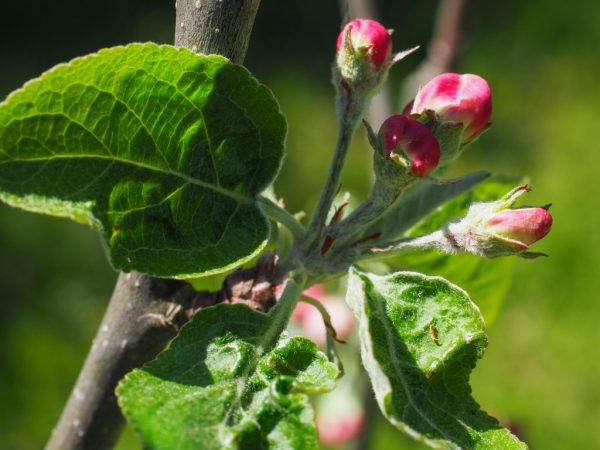
Apple tree blooms in large flowers
The variety is self-fertile, so pollinators must be planted nearby to produce fruit. Most suitable:
- Braburn
- Gala
- Golden
- Junami
- Elstar
The parent variety is not suitable as a pollinator - they have an identical genetic makeup.
The pollinator should grow from the main apple tree at a distance of 50 m. At least one other variety should be planted on 7-8 trees. Sometimes they practice landing in rows.
Harvesting and storage
Harvesting can be done not earlier than the last days of September or at the very beginning of October. If you do this earlier, the fruit will be less tasty.
It is best to carry out cleaning in one step, for 2-3 days.
Apples are carefully picked from the branches and put in boxes. You can cover the layers with wax paper, wood shavings or straw. The fruit has a hard skin so it can be transported without damage.
The crop is stored for a long time, but much depends on the conditions. For example, at room temperature, it will not deteriorate for 3 months. It will stay in the refrigerator for up to six months.
In special chambers, where a certain temperature and humidity are maintained, there is good ventilation, products can lie for 9 months, almost until mid-June.
For home storage of large quantities, a dry, clean basement, with good ventilation and not infected with fungus, is most suitable. Apples are put in boxes, in 2-3 layers. They are placed on special wooden shelves. Once a month, you should revise the fruits, select fruits with signs of rot.
Gardeners reviews
Most of the reviews about the Black Prince apple variety are positive. Delicious juicy fruits can be eaten both in autumn and late spring.
Many people like the original conical shape of the fruit and the rich red hue of the peel. The fine-grained pulp becomes tender and oily during heat treatment, this consistency is ideal for a delicious charlotte or apple cake.
There are also negative reviews. For example, gardeners complain that apples become smaller even with regular watering. Some people write that the crop is unstable, although the description says the opposite.
It is also advised to collect products on time. Apples do not hang on the tree for a long time, they begin to fall off and rot.
The variety is well suited for cultivation in southern regions and in temperate climates. The tree requires shelter for the winter and regular feeding. But the fruits always delight with their sweet and rich taste.


